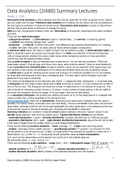Summary
Data Analytics (2IAB0) Summary Lectures 2020
- Course
- Institution
EN: Data Analytics for engineers (2IAB0) is a basis course of the Bachelor College at Eindhoven University of Technology. This means that all Bachelor TUe students should have completed this course. It is given in the third quartile of the first year. Data Analytics for Engineers provides more in...
[Show more]



